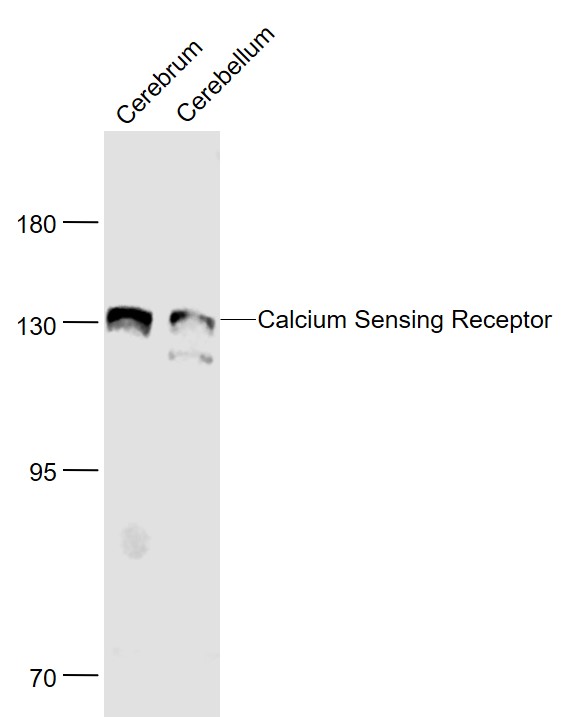
Rabbit Anti-Calcium Sensing Receptor antibody
Ca sensing receptor; Ca2+ sensing receptor 1; Ca2+ sensing receptor; CAR; CaSR; CASR_HUMAN; EIG8; Extracellular calcium sensing receptor; Extracellular calcium sensing receptor [Precursor]; Extracellular calcium-sensing receptor [Precursor]; Extracellular
View History [Clear]
Details
Product Name Calcium Sensing Receptor Chinese Name 钙敏感受体1抗体 Alias Ca sensing receptor; Ca2+ sensing receptor 1; Ca2+ sensing receptor; CAR; CaSR; CASR_HUMAN; EIG8; Extracellular calcium sensing receptor; Extracellular calcium sensing receptor [Precursor]; Extracellular calcium-sensing receptor [Precursor]; Extracellular calcium-sensing receptor; FHH; FIH; GPRC2A; HHC; HHC1; Hypocalciuric hypercalcemia 1; Hypocalciuric hypercalcemia 1 severe neonatal hyperparathyroidism; MGC138441; NSHPT; Parathyroid Ca(2+) sensing receptor 1; Parathyroid Cell calcium sensing receptor; Parathyroid Cell calcium-sensing receptor; PCAR 1; PCAR1. Research Area Tumour Cell biology immunology Neurobiology Signal transduction Growth factors and hormones Kinases and Phosphatases Cytoskeleton Extracellular matrix Immunogen Species Rabbit Clonality Polyclonal React Species Mouse, Rat, (predicted: Human, Cow, Rabbit, Sheep, ) Applications WB=1:500-2000
not yet tested in other applications.
optimal dilutions/concentrations should be determined by the end user.Theoretical molecular weight 118kDa Cellular localization The cell membrane Form Liquid Concentration 1mg/ml immunogen KLH conjugated synthetic peptide derived from human Calcium Sensing Receptor: 71-170/1078 <Extracellular> Lsotype IgG Purification affinity purified by Protein A Buffer Solution 0.01M TBS(pH7.4) with 1% BSA, 0.03% Proclin300 and 50% Glycerol. Storage Shipped at 4℃. Store at -20 °C for one year. Avoid repeated freeze/thaw cycles. Attention This product as supplied is intended for research use only, not for use in human, therapeutic or diagnostic applications. PubMed PubMed Product Detail Extracellular calcium-sensing receptor (CaSR), also designated parathyroid cell calcium-sensing receptor, is an integral membrane protein that belongs to the G protein-coupled receptor 3 family. CaSR is involved in maintaining a stable calcium concentration by acting as an sensor of the extracellular calcium levels for the parathyroid and kidney. Its activity is mediated by a G protein which activates a phosphatidylinositol-calcium second messenger
Function:
Senses changes in the extracellular concentration of calcium ions. The activity of this receptor is mediated by a G-protein that activates a phosphatidylinositol-calcium second messenger system.
Subunit:
Interacts with VCP and RNF19A. Interacts with ARRB1 (By similarity).
Subcellular Location:
Cell membrane.
Tissue Specificity:
Expressed in the temporal lobe, frontal lobe, parietal lobe, hippocampus, and cerebellum. Also found in kidney, lung, liver, heart, skeletal muscle, placenta.
Post-translational modifications:
N-glycosylated.
Ubiquitinated by RNF19A; which induces proteasomal degradation.
DISEASE:
Defects in CASR are the cause of familial hypocalciuric hypercalcemia type 1 (FHH) [MIM:145980]. FHH is characterized by altered calcium homeostasis. Affected individuals exhibit mild or modest hypercalcemia, relative hypocalciuria, and inappropriately normal PTH levels.
Defects in CASR are the cause of neonatal severe primary hyperparathyroidism (NSHPT) [MIM:239200]. NSHPT is a rare autosomal recessive life-threatening disorder characterized by very high serum calcium concentrations, skeletal demineralization, and parathyroid hyperplasia. In some instances NSHPT has been demonstrated to be the homozygous form of FHH.
Defects in CASR are a cause of familial isolated hypoparathyroidism (FIH) [MIM:146200]; also called autosomal dominant hypoparathyroidism or autosomal dominant hypocalcemia. FIH is characterized by hypocalcemia and hyperphosphatemia due to inadequate secretion of parathyroid hormone. Symptoms are seizures, tetany and cramps. An autosomal recessive form of FIH also exists. Defects in CASR are the cause of epilepsy, idiopathic generalized type 8 (EIG8) [MIM:612899]. A disorder characterized by recurring generalized seizures in the absence of detectable brain lesions and/or metabolic abnormalities. Seizure types are variable, but include myoclonic seizures, absence seizures, febrile seizures, complex partial seizures, and generalized tonic-clonic seizures.
Note=Homozygous defects in CASR can be a cause of primary hyperparathyroidism in adulthood. Patients suffer from osteoporosis and renal calculi, have marked hypercalcemia and increased serum PTH concentrations.
Similarity:
Belongs to the G-protein coupled receptor 3 family.
SWISS:
P41180
Gene ID:
846
Database links:
Entrez Gene: 846 Human
Entrez Gene: 12374 Mouse
Omim: 601199 Human
SwissProt: P41180 Human
SwissProt: Q9QY96 Mouse
Unigene: 435615 Human
Unigene: 103619 Mouse
Unigene: 10019 Rat
Product Picture
References (0)
No References
Bought notes(bought amounts latest0)
No one bought this product
User Comment(Total0User Comment Num)
- No comment



 +86 571 56623320
+86 571 56623320
 +86 18668110335
+86 18668110335

